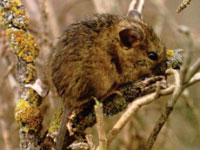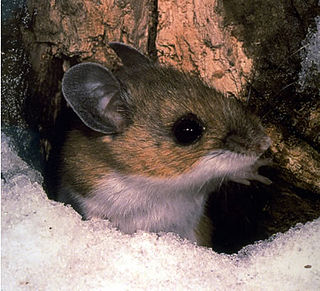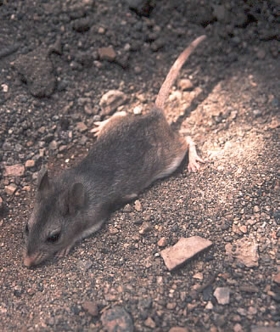
The harvest mouse is a small rodent native to Europe and Asia. It is typically found in fields of cereal crops, such as wheat and oats, in reed beds and in other tall ground vegetation, such as long grass and hedgerows. It has reddish-brown fur with white underparts and a naked, highly prehensile tail, which it uses for climbing. It is the smallest European rodent; an adult may weigh as little as 4 grams (0.14 oz). It eats chiefly seeds and insects, but also nectar and fruit. Breeding nests are spherical constructions carefully woven from grass and attached to stems well above the ground.

The salt-marsh harvest mouse, also known as the red-bellied harvest mouse, is an endangered rodent endemic to the San Francisco Bay Area salt marshes in California.

The Neotominae are a subfamily of the family Cricetidae. They consist of four tribes, 16 genera, and many species of New World rats and mice, predominantly found in North America. Among them are the well-known deer mice, white-footed mice, packrats, and grasshopper mice.

The western harvest mouse is a small neotomine mouse native to most of the western United States. Many authorities consider the endangered salt marsh harvest mouse to be a subspecies, but the two are now usually treated separately.

The hispid cotton rat is a rodent species long thought to occur in parts of South America, Central America, and southern North America. However, recent taxonomic revisions, based on mitochondrial DNA sequence data, have split this widely distributed species into three separate species. The distribution of S. hispidus ranges from Arizona in the west to Virginia to the east and from the Platte River in Nebraska in the north to, likely, the Rio Grande in the south, where it meets the northern edge of the distribution of S. toltecus. Adult size is total length 202–340 mm (8.0–13.4 in); tail 87–122 mm (3.4–4.8 in), frequently broken or stubbed; hind foot 29–35 mm (1.1–1.4 in); ear 16–20 mm (0.63–0.79 in); mass 50–250 g (1.8–8.8 oz). They have been used as laboratory animals.

Reithrodontomys is the genus of groove-toothed New World harvest mice.

The meadow jumping mouse is the most widely distributed mouse in the family Zapodidae. Its range extends from the Atlantic coast in the east to the Great Plains west, and from the arctic tree lines in Canada and Alaska to the north, and Georgia, Alabama, Arizona, and New Mexico to the south. In mid-2014, the New Mexico subspecies of the meadow jumping mouse, Zapus hudsonius luteus, was listed as an endangered species under the federal Endangered Species Act.
The fiery spiny mouse is a species of rodent in the family Muridae found in Kenya and Tanzania. Its natural habitats are dry savanna and rocky areas. It may be found as a commensal in human habitations.
The Forrest's mouse, or desert short-tailed mouse, is a small species of rodent in the family Muridae. It is a widespread but sparsely distributed species found across arid and semi-arid inland Australia, commonly found in tussock grassland, chenopod shrubland, and mulga or savannah woodlands.

The southern grasshopper mouse or scorpion mouse is a species of predatory rodent in the family Cricetidae, native to Mexico and the states of Arizona, California, Nevada, New Mexico, and Utah in the United States. Notable for its resistance to venom, it routinely preys on the highly venomous Arizona bark scorpion.
The Texas mouse is a species of rodent in the family Cricetidae. It is found in Arkansas, Kansas, Missouri, Oklahoma, and Texas in the United States. This species is named in honor of Henry Philemon Attwater.
The fulvous harvest mouse is a species of rodent in the family Cricetidae. It is found in El Salvador, Guatemala, Honduras, Mexico, Nicaragua, and the United States.

The eastern harvest mouse is a species of rodent in the family Cricetidae. It is endemic to the Southeastern United States. Its natural habitats are subtropical or tropical seasonally wet or flooded lowland grassland, swamps, and pastureland.
The Ethiopian white-footed mouse or white-footed stenocephalemys is a species of rodent in the family Muridae. It lives in Ethiopia and Eritrea. Its natural habitats are tropical moist montane forest and tropical high-altitude shrubland.

The spiny pocket mouse is a species of rodent in the family Heteromyidae and order Rodentia. It is found in Baja California in Mexico and in Arizona, California and Nevada.

The pale kangaroo mouse or Soda Spring Valley kangaroo mouse is a species of rodent in the family Heteromyidae. It is endemic to California and Nevada in the United States.

The silky pocket mouse is a species of rodent in the family Heteromyidae. It is found in northern and central Mexico and the southwest region of the United States. It is a species of least concern, according to the IUCN, with no known major threats. The silky pocket mouse eats seeds, succulent parts of plants and nuts, and carries food in its cheek pouches. It lives in low valley bottoms with soft soils, among weeds and shrubs, where it burrows in the sand to bury seed caches. The species is more tolerant of harsh habitat conditions than other pocket mice.

The northern grasshopper mouse is a North American carnivorous rodent of the family Cricetidae. It ranges over much of the western part of the continent, from southern Saskatchewan and central Washington to Tamaulipas in northeast Mexico.

The Pacific pocket mouse, Perognathus longimembris pacificus, is endemic to California. It lives in sandy coastal soils of the coastal sage scrub ecoregion. It eats seeds and some insects. It was believed to be extinct until 1993, when a small population was discovered. It is now a federally listed Endangered animal species.













